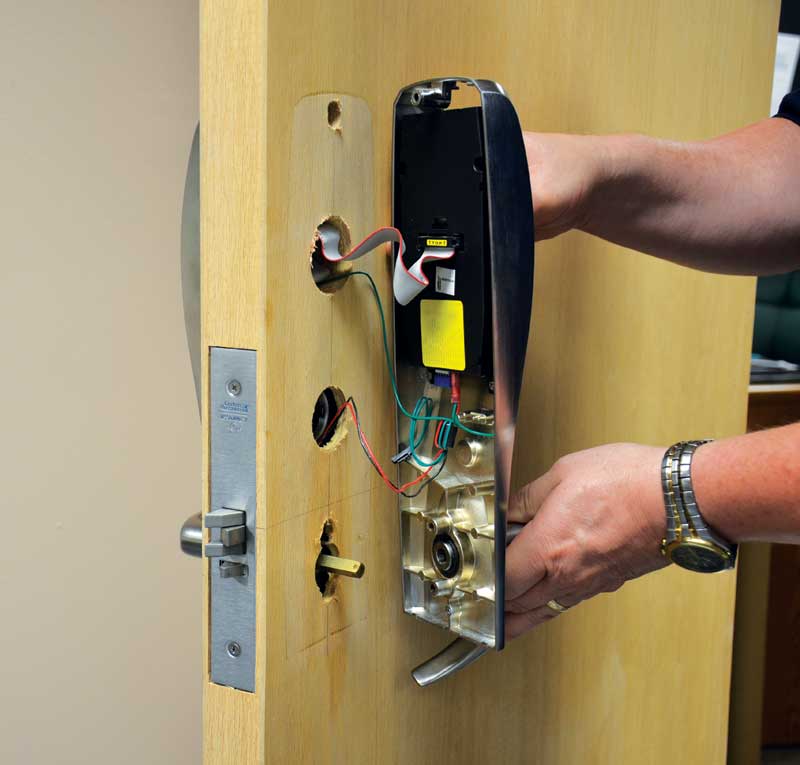Remaking Division 28: Specifying electronic safety and security with Masterformat 2016

Photo courtesy Assa Abloy
Access control
The original Division 28 category breakdown did not well-represent the major product categories for electronic safety and security—this problem had only been compounded by advances in technology since 2004, which is the date of the last major revision.
For security, it is important to note the generally accepted three major product ‘pillars’ of the industry—access control, video surveillance, and intrusion detection. Further, electronic safety encompasses a variety of categories, headlined by fire detection and alarm products. The team’s initial draft featured eight top-level categories, but feedback from CSI indicated this was too many, due to the need to leave room for future expansion. This prompted a critical and thoughtful process to define a limited, but useful, set of five Level 1.5 categories—four in security and one titled “Life Safety.”
To start, “Access Control” was unbundled from “Intrusion” to exist as a standalone category. From there, several significant changes were made.
General Requirements for Access Control Systems
A section was added for “General Requirements for Access Control Systems.”
Access Control Software and Database Management
Under “Access Control Software and Database Management,” expanded subsections were included for Access Control Software (further divided into areas such as operating systems and mobile applications) and Access Control Software Interfaces.
Access Control System Hardware
“Access Control System Hardware” was expanded to provide a more granular breakdown of hardware types, such as network controllers, door controllers, and input/output (I/O) devices.
Access Control Hardware Devices
“Access Control Hardware Devices” was moved over from Division 08 and encompasses those electronic devices that are key components of an access control system, including electrified locking devices and biometrics. Other key additions include:
- “Egress Management Devices;”
- “Telephone Entry Systems;”
- “Intercom Entry Systems;”
- “Electronic Key Management Systems;” and
- “Visitor Management.”
Many of these changes were implemented to address the Division 08/Division 28 dilemma of providing electronic access control devices found in different divisions, compounded by the increasing intelligence at the door. The new structure clearly puts electronic and intelligent devices in Division 28.
Benjamin Williams, CSI, a senior product manager for a major door hardware manufacturer addressed this dilemma.
“Coordination is the key to successful project management. Most of the coordination issues we see on projects today are a result of trying to use traditional 08 71 00 and 08 74 00 specification sections for deliverables that cross over in to multiple sections such as 28 13 00 and 08 71 00,” he explained. “Similar to how automatic operators have been historically specified, utilizing a Section 08 06 71 for door hardware schedule coordination in lieu of traditional specification practices allows the specifier and installer the ability to collaborate on the responsibilities of each party during the installation process in one area of the specification.”
Williams explained the Section 08 06 71 schedule may be incorporated into Part 3 (Execution) of the 08 71 00 door hardware specification. In doing so, a column in the 08 06 71 Schedule may then be used to call out a specific section of the specification responsible for each component of the opening.
“In order to utilize this format, garnering the support of the architect is critical in order to provide a better coordinated specification. As a result, we have focused on the project delivery method and who will be managing the end-of-line terminations and commissioning of the opening. In almost all cases, that is the 28 13 00 contractor. This is without consideration to the timing for the issuance of the bid packages,” Williams says. “For example, 08 71 00 may be bid at an earlier date than Division 28 items, which typically come out with the electrical package.”
Video surveillance
“Video Surveillance” was formerly included as 28 26 00−Electronic Personal Protection Systems, but is now broken out as its own category. Some changes were obvious, such as including, naming, and classifying camera types under a sub-category called “Surveillance Cameras,” instead of “Remote Devices and Sensors.”
In addition to classifying the major types of surveillance cameras, a provision was made for accessories and illuminators. Video analytics was added under “Video Management Systems,” and recording devices are moved under “Storage Appliances in Common Work Results.”






